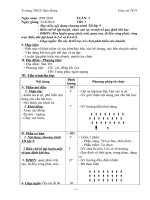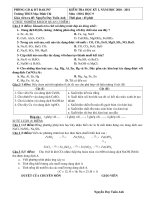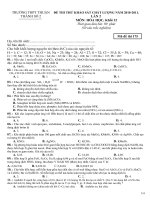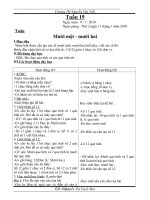Tài liệu MISSISSIPPI GULF COAST COMMUNITY COLLEGE 2011 ECONOMIC IMPACT REPORT doc
Bạn đang xem bản rút gọn của tài liệu. Xem và tải ngay bản đầy đủ của tài liệu tại đây (8.45 MB, 28 trang )
1
MISSISSIPPI GULF COAST COMMUNITY COLLEGE
2011 ECONOMIC
IMPACT REPORT
2011 ECONOMIC IMPACT REPORT
2
Highlights
• The average annual earnings of an MGCCC associate degree graduate after ve
years of employment is
$34,000.
• In 2011, the college set an institutional and state record of 2,114 graduates.
• The college is the
single-largest GED producer in the state with 1,010
GEDs awarded at MGCCC.
• MGCCC workforce training programs increased wages an average of $5,103
per trainee.
• During 2011, more than
10,500 hours of community service and service learning
activities were generated by the students and employees of MGCCC.
• The college employs 1,072 individuals and generates more than $43 million
in labor-income to the four-county service district.
• MGCCC graduates increase their earnings
63 percent during the rst ve years
of their employment.
• The college disbursed more than $41 million in nancial aid to the students
attending 2010-2011.
• Students spend an estimated $137 million each year they attend the college.
Report prepared by Lynn Tincher-Ladner
MGCCC Oce of Institutional Research and Planning
Published by MGCCC Institutional Development, January 2012
MISSISSIPPI GULF COAST COMMUNITY COLLEGE
3
Overview
For 100 years, Mississippi Gulf Coast
Community College has had a rich history
of providing educational, nancial and
economic benets to the communities
served in the college district of George,
Harrison, Jackson and Stone counties.
These benets extend beyond the college’s
operation and contribute to the improved
quality of life for the students and residents
within the four-county district. In FY2011,
more than 36,000 individuals were enrolled
in credit and non-credit development
programs, resulting in stronger and
healthier lifestyles.
With the focus on economic development
as one of its strategic initiatives, this
institutional report reects the impact
on the tax base, employment, county
economic proles and earnings potential
of graduates as well as other pertinent
data contributing to the economic future
of the communities represented.
This 2011 Economic Impact Report further
documents the economic returns in South
Mississippi that have resulted in state, local
and personal investments in Mississippi
Gulf Coast Community College. Findings
in this report are based upon institutional,
state and federal data sources as well as
partnerships with economic experts and
agencies. We look forward to continuing
to invest in the educational and economic
future of our local area, state and region
through instructional excellence and
student success.
Mary S. Graham, Ph.D.
President
2011 ECONOMIC IMPACT REPORT
4
Higher levels of education are a
well-established path to better jobs
and earnings. Estimates of annual
earnings derived from the most
recent publication of education-
attainment data extracted from
a three-year study of the Census
Bureau’s American Community
Survey (ACS) are shown in Exhibit
1. A full-time worker with an
associate degree has 29 percent
higher annual income than a high
school graduate. Mississippi Gulf
Coast Community College is a top
100 associate-degree producing
institution, and is one of the top 10
community colleges recognized by
the Aspen Institute. During 2011,
the college achieved a 27 percent
increase in numbers of graduates,
an institutional and state record
of 2,114 students. In addition to
ongoing completion eorts, this unprecedented
increase was also attributed to a more
streamlined graduation process, an aggressive
recruitment of graduates and the elimination of
graduation fees.
The college’s programs are aligned to the
economic dependence of its service district
on certain industries such as medical,
manufacturing, technical and service/tourism.
In 2011, the college graduated nearly 600
students in nursing and numerous other
health-related occupations; 330 skilled
manufacturing/industrial graduates in areas
such as logistics, drafting, process operations,
welding and electronics. Another 120 students
gained credentials in technical areas such as
computer/web programming, servicing/repair
and networking, and 61 degrees were awarded
to meet service-related industry needs in travel,
tourism and culinary arts.
EXHIBIT 1
Annual Earnings and Employment
by Education Attainment
Full-time, year-round
Workers
Less than full-time,
year-round workers
Median
Earnings
Percent of
Persons
Median
Earnings
Percent of
Persons
None - 8th Grade $23,277 38 $11,237 24
9th - 12th grade $27,470 38 $11,274 28
High school
graduate
$34,147 53 $13,790 25
Some college $40,556 56 $15,604 27
Associate degree $44,086 60 $18,957 26
Bachelor's
degree
$57,026 62 $25,074 26
Master's degree $69,958 60 $38,962 30
Professional
degree
$103,411 67 $49,187 25
Doctorate degree $88,867 68 $50,275 25
Source: U.S. Census Bureau, American Community Survey 2006-2008
Graduates and Earnings
MGCCC was honored to have been named one of
the top 10 community colleges in the competition
for the Aspen Prize.
The 2011 inaugural Aspen Prize recognized
excellence in the nation’s 1,200 community
colleges.
The colleges were ranked according to critical
elements of student success; student learning;
degree completion and transfer; equity and
employment/earnings after college.
5
MISSISSIPPI GULF COAST COMMUNITY COLLEGE
5
In addition to higher earnings, MGCCC graduates are more likely to be employed in a full-time capacity. In fact, it is
estimated that 60 percent of associate degree-holders work full time, 7 percent higher than full-time workers with a
high-school diploma. Overall unemployment rates are also aected by one’s level of education. Based on the Bureau
of Labor Statistics (BLS) for those over age 25, the unemployment of associate-degree holders is 7 percent and for
those with a high school diploma or less, the unemployment rate ranges from 9.2 percent to 15 percent. Exhibit 2
shows the latest gures from the 2010 unemployment rate BLS’s Current Population Survey.
In a recent longitudinal analysis of MGCCC graduates from 2005, data show the average gains from placement and ve
years later were 44 percent for an associate-degree holder and 33 percent increase for a certicate holder. The data in
Exhibit 3 shows the annualized earnings for 2005 graduates working full time and part time in the state of Mississippi.
The college is ranked in the top
100 for producing graduates
out of the 1,200 public two-
year community colleges in
the country. According to this
independent poll, MGCCC ranks
89
th
in producing associate-
degree graduates. This same
poll also ranks MGCCC 45
th
in
producing African-American
graduates, and fth in the nation
for education majors.
Source: Bureau of Labor Statistics, Current Population Survey
EXHIBIT 3
Summary of Annualized Earnings - MGCCC Graduates (2005)
Degree earned
in 2005
2006 2010
Earnings of
associate
degree
graduates
increased
44% over a 5-
year period.
Enrollment
Annual
Earnings
Enrollment
Annual
Earnings
Associate
Degree
785 $23,577 627 $34,003
Career
Diploma
82 $21,957 66 $29,131
Source: Mississippi Unemployment Insurance Data in partnership with National
Strategic Planning & Analysis Center (nSPARC) of Mississippi State University.
2011 ECONOMIC IMPACT REPORT
6
Since the cost of attendance is one of the top reasons
students attend a community/junior college, the
median total cost of attendance by degree type,
inclusive of all tuition, fees, book and testing fees
associated with student accounts receivables is
shown in Exhibit 4. These costs are highly dependent
on the amount of state and local funding as taxpayer
support permits the college to set the lowest tuition
possible and still cover the remainder of education
costs to students.
In addition to the direct cost of the degree, time
spent in school creates an opportunity cost of time
(the earnings forgone). Earnings forgone for the age
and degree level of MGCCC students were estimated
at $15,080 for a full-time student. Using the median
earnings of MGCCC graduates, the break-even points
(length of time for benets to begin to exceed
costs) were estimated. For Pell-eligible students, the
Associate of Arts (A.A) graduate’s estimated break-
even point was 18.3 months and the Associate of
Applied Science (A.A.S.) break-even point was 11.0
months. The diploma graduate was 12.6 months. For graduates not qualied for Pell grants, the break-even point
for an A.A. degree was 26.3 months; the A.A.S. degree was 15.9 months; and Diploma graduates broke even in 18.8
months.
The benets of higher education to the taxpayers go far beyond the increase in tax base for the Gulf Coast economy.
Workers with higher levels of education tend to lead healthier, more productive lives, which translates into savings
for employers and taxpayers. A study conducted for all community colleges in Mississippi reects that increased
education levels have a statistically signicant impact on major socioeconomic factors such as welfare, incarceration,
smoking and alcohol abuse . The study concluded that an associate-degree holder in Mississippi is 25 percent less
likely to abuse alcohol, 26 percent less likely to smoke, 58 percent less likely to be incarcerated, and 75 percent less
likely to be a welfare recipient.
Producing graduates is a primary goal of the institution and generates the highest benet for economic returns to the
individual and the taxpayer.
EXHIBIT 4
Total Cost of Degree
by Degree Type
Degree Type Median Cost Minimum Maximum
Associate of
Arts
$5,544 $5,544 $5,544
Associate
of Applied
Science
$6,165 $5,018 $11,387
Career
Diploma
$4,569 $3,148 $6,553
Source: Based on full-time student rates for fall 2011. Figures include all tuition, fees,
program materials fees, books, certification testing and drug/health screening fees.
MISSISSIPPI GULF COAST COMMUNITY COLLEGE
7
Student Financial Aid and Student Spending
During FY2011
Mississippi Gulf Coast
Community College
disbursed more than
$41.3 million in federal,
state, and institutional
aid to 9,597 students (68
percent of the student
body). Student subsidies
from federal sources
totaled $35.4 million,
another $1.3 million was
from state sources, $3.7
million in institutional
funds and $1.0 million
in external foundation/
private scholarship donations.
Student-related
expenses are a
signicant source
of economic
activity for the
local economy.
Based on the
MGCCC Oce of
Financial Aid 2011
annual student
budgets, the 6,980
full-time students
enrolled in the
fall 2010 semester spent
an estimated $93 million in the local economy (non-tuition related expenses, and the 3,093 part-time students spent
an additional $45 million. Beginning in 2011, students and parents can now obtain an estimate of what it may cost
to attend Mississippi Gulf Coast Community College. The college’s Net Price Calculator provides the student with the
annual cost of attendance, minus grants and scholarships. The calculator is located on the college’s website at http://
www.mgccc.edu/future_students/net_price_calculator.php.
EXHIBIT 5
Distribution of Financial Aid by Category County
County Federal State Institutional External Total
George $859,812 $12,125 $40,515 $2,800 $915,252
Harrison $15,323,673 $557,717 $822,467 $249,582 $16,953,439
Jackson $13,004,016 $402,627 $875,828 $506,702 $14,789,173
Stone $6,181,162 $313,096 $1,932,421 $238,527 $8,665,206
Total $35,368,663 $1,285,565 $3,671,231 $997,611 $41,323,070
EXHIBIT 6
Student Spending Estimates
BUDGET FULL TIME PART TIME SPENDING SPENDING
O campus, in-state $16,947 1848 1533 $31,323,737 $25,972,423
Living with parent $13,122 3529 1268 $46,307,465 $16,636,745
On-campus $10,232 1451 251 $14,842,459 $2,566,020
Living out of state - 152 42 - -
Totals 6,980 3,093 $92,473,660 $45,175,188
Source: />Source: Office of Financial Aid, 2011 annual student budgets
2011 ECONOMIC IMPACT REPORT
8
Students Served and Online Education
During 2010-2011, the college served more than 14,000 students in credit programs at the college’s eight locations.
These students were enrolled in 258,625 hours of credit. Exhibit 7 shows the enrollment activity in each county.
The college has experienced signicant growth in courses taken online. Over the past ve years, online credit-hour
enrollment has increased 81 percent. The trend is shown in Exhibit 8.
EXHIBIT 7
2010 – 2011 Annual Enrollment and Credit Hours
UNIVERSITY
TRANSFER
TECHNICAL CAREER TOTALS
ENROLLMENT
CREDIT
HOURS
ENROLLMENT
CREDIT
HOURS
ENROLLMENT
CREDIT
HOURS
ENROLLMENT
CREDIT
HOURS
George 390 6,244 21 320 118 2,119 529 8,683
Harrison 4,789 82,919 1,268 20,096 389 8,027 6,446 111,042
Jackson 3,841 70,766 1,341 19,751 228 3,659 5,410 94,176
Stone 1,410 37,071 319 5,738 79 1,915 1,808 44,724
Totals 10,430 197,000 2,949 45,905 814 15,720 14,193 258,625
Source: Audited enrollment files MGCCC Department of Institutional Research and Planning
Source: Office of Institutional
Research and Planning
MISSISSIPPI GULF COAST COMMUNITY COLLEGE
9
The college has responded to growth in online enrollment by increasing the number and variety of course oerings,
increasing investments in instructional technologies, and providing extensive professional training of online
instructors. The student body has changed in both size and preference of instructional format. Approximately one-
third of students take at least one online class. Online courses are oered as versions of traditional classes through
the Mississippi Virtual Community College (MSVCC) network. Exhibits 9 and 10 compare fall 2006 and fall 2010
enrollment by hours of online courses.
Renamed eLearning in June 2010, the
college’s distance-learning program has had
an enrollment growth from 1,324 students
in fall 2000 to 5,591 in fall 2009. On average,
unduplicated enrollment has increased
by 20 percent every year since 2000 and
increased by more than 22 percent between
spring 2009 and spring 2010. Almost 500
online classes were oered at Mississippi
Gulf Coast Community College in the 2009-
2010 academic year, with the majority of
these classes taught by full-time college
faculty.
There are degree programs in more than
12 dierent areas that can be completed
online, including eight Associate of Arts
degrees and four Associate of Applied
science degrees. Several other degree
programs can be completed online, with the
exception of a few classes. Fast-track online
and hybrid plans are available for students
at all campuses and centers. These plans
combine day, night, weekend (hybrid) and
online classes to oer total exibility to both
nontraditional and traditional students.
2011 ECONOMIC IMPACT REPORT
10
Developmental and Adult Education
The purpose of adult basic education is to
increase the number of students who are
entering employment, seeking employment
retention, obtaining a GED, and/or making
the transition into post-secondary education
and training programs. The college served
2,938 students in Adult Basic Education and
English as a Second Language programs. These
programs generated more than 1,000 GED
graduates. The college is not only the single-
largest producer of GED graduates in the state
of Mississippi, but the institution also plans for
these graduates to transition to credit programs
through counseling and institutional subsidies
such as performance-based GED scholarships.
Exhibit 11 shows the post-Katrina enrollment
of GED students at MGCCC. Of these students,
96 percent obtain their GED at the College prior
to entering a credit program, and Exhibit 12
shows drop-out recovery eorts by county.
As part of the admissions process, the college determines student readiness in an eort to increase success in college-
level coursework. Developmental courses are oered to remediate reading, English and math skills. Approximately one in
three new students is placed in at least one developmental course. Of the 2,521 new rst-time, rst-year college students
entering MGCCC in fall 2011, 809 or 32 percent, were classied as
developmental students. Of all students enrolled in fall 2011, 17
percent were classied as developmental.
Congruent with previous studies, the 2011 success rate of
developmental students in both college algebra and freshman
English composition was equal to or better than those students
classied as “non-developmental” by evaluation of high-school
transcripts and/or ACT test scores. Additionally, developmental
students were less likely to withdraw from subsequent coursework
than non-developmental students. These eorts resulted in 675 (32
percent) graduates in the class of 2011 who, at the time of entry to
the institution, were classied as developmental students.
Through the combined eorts of developmental and adult
education, 770 students were able to obtain a college degree
in 2011. It is estimated that the median annual tax payments of
these graduates will be $7,161,000 .
Source: Office of Institutional Research and Planning
Source: Office of Institutional Research and Planning
MISSISSIPPI GULF COAST COMMUNITY COLLEGE
11
Workforce Development
Workforce training represents the
largest non-credit initiative for
Mississippi Gulf Coast Community
College, serving 16,500 students
through individual training and
partnerships with more than 65
companies throughout South
Mississippi. The economic impact of
this training is realized through gains in
income for those trained. The average
annual wage increase for workers
in FY2010 was $5,103, and median
annual earnings among trainees
was $39,664. Training received in
industrial, welding and blueprint
reading yielded the highest increases
in annual wages. Exhibit 13 captures
the salary increases by training
category.
Community, economic and
workforce development programs
and services at the right place and
right time may be customized, proprietary or vender-specic. Services available to business/industry and the residents
of the college district include the following:
• Pre- and post-employment screening, testing and
training
• Eligibility for tax credits
• Funding of workforce training
• Curriculum development and customized training
materials
• Mobile training labs with state-of-the-art equipment
The college also promotes economic development of the
community’s workforce through partnership with the Mississippi
Department of Employment Security Workforce Investment
Network. The college works in conjunction with workforce
partners to provide and support the many services made
available through Mississippi’s Workforce Investment Network
(WIN Job Centers). The unduplicated headcounts of FY2011
workforce trainees by county of service are given in Exhibit 14.
Source: Mississippi Unemployment Insurance Data in partnership with National Strategic Planning & Analysis Center
(nSPARC) of Mississippi State University
Source: Office of Institutional Research and Planning
2011 ECONOMIC IMPACT REPORT
12
Society and Community Benets
During 2011, nearly 3,000 students and 400 employees participated in community service or service learning events. These
eorts generated 10,525 hours of community service. More than 25 percent of the students attending MGCCC participated
in volunteerism, service-learning or community service activities in FY2011. Exhibit 15 shows the distribution of service
hours by category.
Some examples of FY2011 community service events included fundraising for breast cancer, heart and arthritis
research; services for Martin Luther King Jr. Day; ministry to homeless and poor; reading projects at area elementary
schools; food and blood drives; voter registration and awareness activities; workshops and activities for children in
partnership with the Lynn Meadows Discovery Center; vision screening for children; health and health awareness fairs;
area clean up; and March of Dimes.
Service is a vital part of student learning and is one of the many ways Mississippi Gulf Coast Community College adds
value to its surrounding communities. Along with this direct impact of community and service learning projects,
students attending college are also more likely to continue to volunteer within the community.
HOURS
Source: />MISSISSIPPI GULF COAST COMMUNITY COLLEGE
13
Programs with Special Impact
on the Community
While the college’s mission encompasses a large variety of credit and non-credit initiatives to increase the education
levels of citizens of the Gulf Coast, Mississippi Gulf Coast Community College sponsors numerous other programs with
special impacts on the community. In this report, the college spotlights three such programs: the Gulf Coast Youth
Leadership Program (GCYL), the Lifelong Learning Institute (LLI) and Travel to Learn.
• The Gulf Coast Youth Leadership Program: The
purpose of the Gulf Coast Youth Leadership Program
is to develop high school students into leaders
who are informed, motivated and committed to
working toward an improved quality of life. The
goal of the one-year program is to identify and
develop youth with leadership skills and provide an
in-depth knowledge of the Gulf Coast community.
The program is based on the basic principles of
adult leadership programs operating in the Coastal counties and at the state level. The value-based program
of personal development involves business/industry leaders through presentations, eld trips and mentors.
Core to the program’s curriculum is economic development. The college served 26 students during the FY2011
program year. To learn more about the GCYL program visit, />• The Lifelong Learning Institute: Mississippi Gulf
Coast Community College provides an educational
opportunity designed to meet the needs of America’s
maturing population through the MGCCC Lifelong
Learning Institute (LLI). Mature adults who care about
lifelong learning, who are self-motivated, and who
wish to continue their experiences with other like-
minded individuals are what the LLI is about.
• Travel to Learn: The Travel to Learn department oers
open-to-the-public travel to individuals with inquiring
minds and adventurous spirits. These trips may be day
trips or extended overnight trips. MGCCC organizes the
transportation and travel details so that participants
can spend time enjoying the scenery. All trips expose
the traveler to some form of cultural, historical or artistic
adventures.
MGCCC
Gulf Coast Youth Leadership
GCYL
2011 ECONOMIC IMPACT REPORT
14
Impact of College Employment
and Capital Projects
Mississippi Gulf Coast Community College
is a major employer in South Mississippi.
The college disbursed $38 million to more
than 1,072 employees during scal year
2011 and paid more than $10 million in
fringe benets. Most of this income is
disbursed locally, and more than 90 percent
of the college’s employees live within the
four-county district. Exhibit 16 shows the
college’s employment by National Center for
Education Statistics classications.
When combined, the municipalities in
the college’s service area represent the
largest center of economic activity south
of Jackson. Employment and income multiplier models relative to the impact of Gulf Coast were generated using
IMPLAN by State Senior Economist Dr. Bob Neal. Using the labor-income multipliers for each county, the college’s
employment adds an additional 160 full-time jobs to the district. Exhibit 17 shows that the total labor-income
impact based on the
ZIP code of the college
employees within the
four-county district was
$47 million.
The institution’s
capital projects serve
as another signicant
direct economic impact
to South Mississippi. These expenditures directly create jobs and generate additional economic activity. During
FY2011, expenditures for the college’s capital projects totaled $6.5 million.
EXHIBIT 16
College Employment Based on Employee Zip Code
National Center for Education
Statistics Employment
Classication
In-District
Out-of-
District
All
FT PT FT PT FT PT
Instruction/Faculty 283 200 37 52 320 252
Administrative/Executive 77010780
Other Professional 52 20 2 3 54 23
Technical Sta 14000140
Clerical/Secretarial Sta 113 36 6 5 119 41
Skilled Craft Sta 101 1 2 0 103 1
Service/Maintenance Sta 43 21 2 0 45 22
Totals 683 278 50 61 733 339
EXHIBIT 17
Labor Income Impact of College Employment
George Harrison Jackson Stone
Out-of-
District
Labor Income $1,699,271 $11,942,197 $11,479,182 $9,060,614 $3,786,188
Added-Impact $475,796 $5,373,989 $4,706,465 $2,174,547 -
Total Impact $2,175,067 $17,316,186 $16,185,647 $11,235,161 $3,786,188
Source: Office of Institutional Research and Planning
Source: IMPLAN calculations by Dr. Bob Neal, State Senior Economist
Capital Projects
Jackson County Harrison County Stone County
A 2,000 square-foot greenhouse, located at the
Estuarine Education Center, was completed
in September 2010. The Native Vegetation
and Plant Greenhouse construction and
educational programs are funded by the
Coastal Impact Assistance Program from
the Bureau of Ocean Energy Management,
Regulation and Enforcement through a
$500,000 grant award to the Mississippi
Department of Marine Resources.
The construction of a 50,000 square-foot
Hospitality and Resort Management Center
began in spring 2011 east of DeBuys Road. The
primary purpose of the facility is to promote
the Coast’s tourism economy. Approximately
half of the estimated cost for the design and
construction of the training and education
center will be provided through local funding.
A state-of-the-art Athletic Performance
Facility was completed in spring 2011. An
18,906 square-foot Learning Resources
Center (LRC) is under construction to house the
Perkinston Campus Library; college-sponsored
tutorial labs; an open computer laboratory; and
Media Services.
MISSISSIPPI GULF COAST COMMUNITY COLLEGE
15
The mission statement of Mississippi
Gulf Coast Community College
requires the institution to provide
higher education opportunities for
the citizens of George, Harrison,
Jackson, and Stone counties.
As a consequence, economic
improvement is at the forefront
of the institution’s planning and
budgeting eorts. The college
rst formally identied economic
development as a strategic planning
initiative in 1999, and in the most
recent publication of the Strategic
Plan for MGCCC, the initiative
for “Economic and Community
Development” states the following:
Desired Outcome: Through all
programs and services, the college
will promote the improvement of the
economic and cultural quality of life in
the community.
The college will provide responsive
and innovative programs that support
the economic, workforce and cultural
development of the community. The
college will continue to enhance
partnerships with business, industry,
other educational institutions, public
agencies and private organizations
to improve the quality of life on the
Mississippi Gulf Coast.
Economic development is a planning
priority. Operationally, the college is
divided into 104 discrete planning
units representing all education,
service and administrative areas
of the college. In 2011, employees
developed 1,429 eectiveness
outcomes to monitor the forward
movement of the Strategic Plan. Of
these outcomes, 437 (31 percent)
were directed toward economic
development of the four-county
district.
Strategic Planning
2011 ECONOMIC IMPACT REPORT
16
George County Impact Summary
STUDENTS SERVED
PROGRAM TYPE COUNT
Degree-Seeking Programs 529
FT Students 300
PT Students 229
Workforce Training 681
Adult Education 195
Lifelong Learning 63
Other Continuing Education 82
Secondary Programs 193
Total Served 1,743
9
ECONOMIC AND TYPOLOGY
CLASSIFICATIONS
Unemployment Rate 10.1%
Poverty Rate 16.2%
Per capita income $18,505
Median Household Income $43,043
Average Weekly Wages $569
Metro/Nonmetro Classication Metro
Rural-to-Urban Continuum Code (1-9) 3
Economic Dependence Nonspecialized
TOP 5 INDUSTRIES FOR EMPLOYMENT
(2010)
Industry Percent of
Employment
Construction 18.6%
Manufacturing 18.4%
Retail Trade 12.5%
Health Care/Social Assistance 9.4%
Educational Services 8.9%
TOP 5 PROJECTIONS FOR EMPLOYMENT
(2015)
Industry Percent of
Employment
Construction 19.7%
Manufacturing 19.8%
Retail Trade 13.5%
Health Care/Social Assistance 10.0%
Educational Services 9.5%
POPULATION
Total Population 22,578
Percent change from 2000 to 2010 17.9%
3,434
Primary language other than English 2.5.%
523
Female 49.4%
1,115
Persons under 18 years 26.8%
6,051
Persons 65 years and older 12.8%
2,890
Persons 18 – 64 years old 60.4%
13,637
Non-GED Graduates 120
GED Graduates 70
Total Graduates 190
MISSISSIPPI GULF COAST COMMUNITY COLLEGE
17
EMPLOYMENT AND SPENDING
Employees living in George County 55
FT Employees 32
PT Employees 23
Total Employment Impact 44
Total Labor Income Impact $2,175,067
Capital Spending $364,215
OTHER STUDENT CHARACTERISTICS 2011
Average Age/Percent Female 25/68%
Average Class Size 18
Courses Oered in George County 943
Academic Transfer (ground) 101
Career/Technical (ground) 61
Online Courses 781
Credit Hours Awarded (passed) 7,753
EDUCATIONAL ATTAINMENT OF THOSE
25 AND OLDER
Less than 9th Grade 6.9% 947
9th – 12th Grade, No Diploma 13.9% 1,907
High School Graduate 41.1% 5,639
Some college, No Degree 20.7% 2,840
Associate’s Degree 5.2% 713
Bachelor’s Degree 8.0% 1,098
Graduate or Professional 4.2% 576
Total Less than Associate 82.6% 11,333
George County
Board of
Supervisors
Henry Cochran
Sue Cochran
Fred Croom
Larry Havard
Kelly Wright
MGCCC
Locations
George County Center
11203 Hwy. 63 S
Lucedale, MS 39452
2011 ECONOMIC IMPACT REPORT
18
Harrison County Impact Summary
STUDENTS SERVED
PROGRAM TYPE COUNT
Degree-Seeking Programs 6,446
FT Students 3,674
PT Students 2,772
Workforce Training 6,813
Adult Education 1,473
Lifelong Learning 64
Other Continuing Education 885
Total Served 15,681
59
ECONOMIC AND TYPOLOGY
CLASSIFICATIONS
Unemployment Rate 8.9%
Poverty Rate 18.2%
Per capita income $22,444
Median Household Income $42,337
Average Weekly Wages $663
Metro/Nonmetro Classication Metro
Rural-to-Urban Continuum Code (1-9) 3
Economic Dependence
Federal/State Gov
TOP 5 INDUSTRIES FOR EMPLOYMENT
(2010)
Industry Percent of
Employment
Health Care/Social Assistance 12.1%
Retail Trade 11.5%
Construction 10.5%
Accommodation/Food Service 9.6%
Entertainment/Recreation 8.1%
TOP 5 PROJECTIONS FOR EMPLOYMENT
(2015)
Industry Percent of
Employment
Health Care/Social Assistance 12.9%
Retail Trade 12.3%
Construction 11.1%
Accommodation/Food Service 10.3%
Entertainment/Recreation 8.5%
POPULATION
Total Population 187,105
Percent change from 2000 to 2010 -1.3%
-2,496
Primary language other than English 7.0%
12,128
Female 50.3%
94,113
Persons under 18 years 24.5%
45,840
Persons 65 years and older 11.7%
21,891
Persons 18 – 64 years old 63.8%
119,374
Non-GED Graduates 978
GED Graduates 494
Total Graduates 1,472
MISSISSIPPI GULF COAST COMMUNITY COLLEGE
19
EMPLOYMENT AND SPENDING
Employees living in Harrison County 321
FT Employees 232
PT Employees 89
Total Employment Impact (FTE) 330
Total Labor Income Impact $17,316,186
Capital Spending $5,099,601
OTHER STUDENT CHARACTERISTICS 2011
Average Age/Percent Female 26.3/62%
Average Class Size 22
Courses Oered in Harrison County 2,196
Academic Transfer (ground) 966
Career/Technical (ground) 449
Online Courses 781
Credit Hours Awarded (passed) 84,624 HRS
EDUCATIONAL ATTAINMENT OF THOSE
25 AND OLDER
Less than 9th Grade 5.2% 5,976
9th – 12th Grade, No Diploma 11.2% 12,871
High School Graduate 30.0% 34,478
Some college, No Degree 25.5% 29,306
Associate’s Degree 8.5% 9,768
Bachelor’s Degree 12.4% 14,251
Graduate or Professional Degree 7.2% 8,274
Total Less than Associate 71.9% 82,631
Harrison
County Board of
Supervisors
Marlin Ladner
William Martin
Connie Rockco
Kim Savant
W.S. Swetman III
MGCCC
Locations
Jeerson Davis Campus
West Harrison County Center
Keesler Center
Naval Construction Battalion Center
Advanced Manufacturing &
Technology Center
2011 ECONOMIC IMPACT REPORT
20
Jackson County Impact Summary
STUDENTS SERVED
PROGRAM TYPE COUNT
Degree-Seeking Programs 5,410
FT Students 3,132
PT Students 2,278
Workforce Training 8,311
Adult Education 1,056
Lifelong Learning 71
Other Continuing Education 1,190
Total Served 16,036
33
ECONOMIC AND TYPOLOGY
CLASSIFICATIONS
Unemployment Rate ( Oct. 2010) 9.4%
Poverty Rate 14.1%
Per capita income $22,256
Median Household Income $48,197
Average Weekly Wages $851
Metro/Nonmetro Classication Metro
Rural-to-Urban Continuum Code (1-9) 3
Economic Dependence Manufacturing
TOP 5 INDUSTRIES FOR EMPLOYMENT
(2010)
Industry Percent of
Employment
Manufacturing 18.1%
Retail Trade 10.8%
Health Care/Social Assistance 10.1%
Construction 9.6%
Accommodations/Food Service 8.5%
TOP 5 PROJECTIONS FOR EMPLOYMENT
(2015)
Industry Percent of
Employment
Manufacturing 18.7%
Retail Trade 11.0%
Health Care/Social Assistance 10.3%
Construction 9.8%
Accommodations/Food Service 8.7%
POPULATION
Total Population 139,668
Percent change from 2000 to 2010 6.3%
8,248
Primary language other than English 5.3%
6,899
Female 50.7%
70,811
Persons under 18 years 25.5%
35,615
Persons 65 years and older 12.4%
17,318
Persons 18 – 64 years old 62.1%
86,735
Non-GED Graduates 813
GED Graduates 383
Total Graduates 1,196
MISSISSIPPI GULF COAST COMMUNITY COLLEGE
21
EMPLOYMENT AND SPENDING
Employees living in Jackson County 323
FT Employees 219
PT Employees 104
Total Employment Impact (FTE) 254
Total Labor Income Impact $16,185,647
Capital Projects Spending $3,360,894
OTHER STUDENT CHARACTERISTICS 2011
Average Age/Percent Female 25.8/60%
Average Class Size 22
Courses Oered in Jackson County 2,027
Academic Transfer (ground) 862
Career/Technical (ground) 384
Online Courses 781
Credit Hours Awarded (passed) 77,954 HRS
Federal
$13,004,016
EDUCATIONAL ATTAINMENT OF THOSE
25 AND OLDER
Less than 9th Grade 4.1% 3,508
9th – 12th Grade, No Diploma 11.6% 9,925
High School Graduate 34.3% 29,347
Some college, No Degree 23.6% 20,192
Associate’s Degree 8.6% 7,358
Bachelor’s Degree 11.7% 10,010
Graduate or Professional Degree 6.1% 5,219
Total Less than Associate 73.6% 62,972
Jackson County
Board of
Supervisors
Tommy Brodnax
Melton Harris
Mike Mangum
John McKay
MGCCC
Locations
Jackson County Campus
2300 Highway 90
Gautier, MS 39553
2011 ECONOMIC IMPACT REPORT
22
STUDENTS SERVED
Degree-Seeking Programs 1,808
FT Students 1,554
PT Students 254
Workforce Training 513
Adult Education 214
Lifelong Learning 121
Other Continuing Education 255
Total Served 2,911
Total Served 16,036
3
GED
63
ECONOMIC AND TYPOLOGY
CLASSIFICATIONS
Unemployment Rate 8.8%
Poverty Rate 19.1%
Per capita income $19,745
Median Household Income $38,046
Average Weekly Wages $605
Metro/Nonmetro Classication Metro
Rural-to-Urban Continuum Code (1-9) 3
Economic Dependence Manufacturing
TOP 5 INDUSTRIES FOR EMPLOYMENT
(2010)
Industry Percent of
Employment
Manufacturing 10.1%
Health Care/Social Assistance 12.7%
Retail Trade 11.0%
Construction 10.0%
Accommodations/Food Services 8.9%
TOP 5 PROJECTIONS FOR EMPLOYMENT
(2015)
Industry Percent of
Employment
Manufacturing 10.9%
Health Care/Social Assistance 13.7%
Retail Trade 11.8%
Construction 10.7%
Accommodations/Food Services 9.5%
POPULATION
Total Population 17,786
Percent change from 2000 to 2010 30.6%
4,164
Primary language other than English 1.6%
266
Female 49.9%
8,875
Persons under 18 years 24.4%
4,339
Persons 65 years and older 12.1%
2,152
Persons 18 – 64 years old 63.5%
11,295
Stone County Impact Summary
Non-GED Graduates 131
GED Graduates 63
Total Graduates 194
MISSISSIPPI GULF COAST COMMUNITY COLLEGE
23
EMPLOYMENT AND SPENDING
Employees living in Stone County 262
FT Employees 200
PT Employees 62
Total Employment Impact (FTE) 247
Total Labor Income Impact $11,235,161
Capital Projects Spending $304,357
OTHER STUDENT CHARACTERISTICS 2011
Average Age/Percent Female 21.3/52%
Average Class Size 19
Courses Oered in Stone County 1,653
Academic Transfer (ground) 715
Career/Technical (ground) 157
Online Courses 781
Credit Hours Awarded (passed) 37,309
External
$238,527
Institutional
$875,828
State
$313,096
Federal
$6,181,162
Total Aid Distributed - $8,665,206
EDUCATIONAL ATTAINMENT OF THOSE
25 AND OLDER
Less than 9th Grade 8.3% 837
9th – 12th Grade, No Diploma 14.7% 1,484
High School Graduate 30.2% 3,049
Some college, No Degree 23.0% 2,322
Associate’s Degree 10.9% 1,100
Bachelor’s Degree 8.8% 888
Graduate or Professional Degree 4.1% 413
Total Less than Associate 76.2% 7,692
Stone County
Board of
Supervisors
Dale T. Bond
Clark Byrd
Daniel Harris
Wendell Patton Sr.
Lance Pearson
MGCCC Locations
Perkinston Campus
51 Main Street
Perkinston, MS 39573
2011 ECONOMIC IMPACT REPORT
24
FY2013PriorityNo.1•Mid-Level
Funding ($76,972,460)
Passed by the Legislature in 2007,
Mid-Level Funding is state law and a
pledge to fund community colleges
at a per-student allowance that is
midway between the per-student
state allowance for K-12 students
and regional university students. A
state funding increase of $2,366 per
student is needed to
reach that mandate.
The community
colleges are asking
for one-half of that
amount in FY 2013
- about $77 million. The average
annual cost of tuition and required
fees at community and junior
colleges is currently $2,174 (FY 2012),
up 2.84 percent from the previous
year. Our colleges are serving 30
percent more students than three
years ago. The number of graduates
produced by Mississippi community
colleges increased by 14 percent in
2010-11. Community colleges are
the higher-education entry point for
the majority of Mississippi college
students. Capping enrollment and
raising tuition will defeat Mississippi’s
goal of producing more college
graduates.
FY2013PriorityNo.2•Capital
Improvements ($166,000,000)
The MACJC Five-Year Capital
Improvement Plan identies the
need for new facilities and capital
improvements costing more than
$695 million. As the fastest-growing
segment of higher education,
community and junior colleges must
have facilities that support escalating
enrollment and quality instructional
programs and workforce training.
From 1990 to 2010, community and
junior colleges received less than a
third ($333,877,013) of the amount
of state bonds awarded to public
universities ($1,137,932,000) during
the same time period.
The disparity continued in 2011
when the Legislature appropriated
$98.9 million in state bond funds
for IHL, while community colleges
received only $25 million in state
bond funds. MACJC is requesting
$166 million in state bond funds for
FY 2013. The funds will be distributed
in the following manner: one-half
evenly among the 15 institutions and
the balance to be distributed based
on enrollment. In addition, MACJC is
endorsing a separate $9 million bond
bill to fund the construction and
furnishing of a new headquarters
building for the Mississippi
Community College Board.
FY2013PriorityNo.3•Dropout
Recovery Initiative ($11,469,500)
Last year, Mississippi spent only
$387 per Adult Education student
enrolled at community colleges. Of
the 20,489 Adult Education students
served, only 3,067 were functioning
at the 8th-grade level or above.
About 14,000 students leave the
K-12 system each year without a high
school diploma.
The Dropout
Recovery Initiative
is the community
college plan to
“recover” at least
one-fourth of those students by
preparing them to pass the GED and
oering short-term skills training
and support services while they work
toward that goal. But that is only
possible if the Legislature increases
funding per Adult Education student
to the same level of support provided
to students enrolled in the regular
college program. (14,000 dropouts
per year x 25 percent {percent of
students to be served} = x 3,500
students x $3,277 [FTE state funding
per student] = $11,469,500.)
A separate, special appropriation is
requested to fund this initiative.
Funding Priorities for 2013
MISSISSIPPI GULF COAST COMMUNITY COLLEGE
25
Operational Budget
For the 2011 budget year, the institution was provided $20.1 million in state appropriations. The total taxpayer
contribution to the operation of the college was $38.95 million, or 39 percent of the operating costs of the insti-
tution, capital projects and loan-payment plans.
Unrestricted
E&G
Expenditure:
$58,772,888
Restricted E&G
Expenditure
$40,736,760
Total
Expenditure:
$99,509,64
Unrestricted
E&G Revenue: $64,226,312
Restricted E&G
Revenue: $41,577,633
Total
Revenue: $105,803,945
Source: MGCCC Office of the Comptroller
Source: MGCCC Office of the Comptroller









